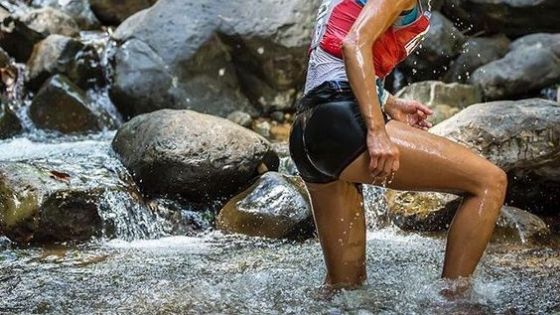
Waterproof running shoes have their place. But when out of place, it can turn out to be disastrous. Ask my friend, Alan. Alan takes he’s running seriously. From over-training to head to toe branded gear –everything had to be just “right” – the Allan way.
Before our first trail race, we both studied the route. Sure thing. There was a small river crossing. Twice. I thought it to be no big deal. Allan on the other hand, decided when there’s water, there’s a problem.
So, with typical Allen precision, he needed to “fix” the problem. The solution? Waterproof running shoes! It turned out, the “big river “was only a trickle. Allen still lives to tell the tale of that pair of waterproof shoes as his one mistake best forgotten.
Are trail-running shoes waterproof? A wide selection of waterproof trail running shoes are available on the market, each varying in waterproofness, ranging from totally waterproof, to water-resistant to water repellent, all intended to keep water out to a varying degree.

Waterproof trail running shoes make a relatively small segment of the total trail running shoe market. Even so, the degree of waterproofing varies between shoes. The waterproofing is done by means of a coating or built-in liner in the fabric uppers of the shoe that creates a waterproof barrier.
Mountaineering Technology on Your Feet
In order for trail running shoes to be totally waterproof, they often feature technology that keeps the cold and wet at bay. All of this needs to be done while still allowing proper ventilation or else your feet will sweat. To do this the membrane used for the liner features GORE-TEX technology. This is the same GORE-TEX technology that has been used to create the outer shell layer of mountaineering jackets for decades.
How do waterproof shoes work?
For years the problem with fully waterproof fabric is that it used to have a relatively thick rubberized lining. The belief at the time was that in order to be waterproof the fabric had to be completely airtight. The theory being that anywhere that air could get in, water would get in as well.
The problem with rubberized fabric is that the inside would be like a sauna and you would be drenched in sweat. At least you would be warm and wet in icy conditions.
These days the only things I have seen those using that old airtight fabric have been hazmat suits and body bags.
The game-changer for waterproof comfort was the advent of the GORE-TEX membrane.
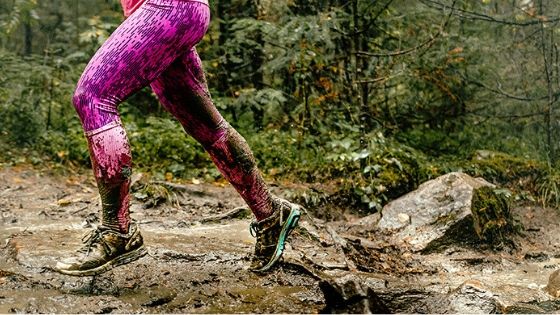
What is GORE-TEX?
GORE-TEX is a scientific membrane that contains billions of pores per square inch, each of which is 20,000 times smaller than a water droplet. So water has absolutely no chance of getting in. What makes the membrane even more brilliant: those pores are also 700 times larger than water vapor (i.e. sweat) molecules. So sweat can easily escape.
I am not saying that you stay completely dry. The nature of GORE-TEX is that it will allow your sweat to evaporate through the membrane. Because your sweat is able to evaporate through the GORE-TEX membrane it will help you to stay comfortable for longer.
Even though GORE-TEX was invented and patented all the way back in 1969, it was only during the mid to late 1980s that it started to become really mainstream with regard to hiking and mountaineering outer-shell clothing.
Does GORE-TEX Break Down?
When it comes to wearing out, GORE-TEX is an interesting fabric. While it is very thin and super fragile on its own it does not tend to wear out nearly as quickly as other synthetic fabrics. This is because GORE-TEX gets much of its structural integrity from the “host” fabric that the membrane is attached to.
However, the thin delicate nature of the GORE-TEX membrane means that any abrasion areas of your shoes or garment run the real risk of the membrane rubbing or wearing off the host fabric.
Being a synthetic product it degrades a lot faster under direct UV light. This UV degradation not only affects the GORE-TEX membrane but also the host fabric. This combination has caused the GORE-TEX membrane to delaminate in a couple of my mountaineering jackets over the years.
Why Does GORE-TEX Leak?
Almost all instances of where people complain about GORE-TEX leaking is not actually leaking in the true definition of the word. It is, instead, an unfortunate consequence of how the membrane functions. Let me explain.
When the GORE-TEX lined fabric gets wet, water droplets block the micropores, thereby creating the waterproof barrier. This same waterproof barrier will prevent any sweat vapor from escaping. If that build-up of sweat vapor continues for long enough, you will get to the critical point where the vapor will start to condense into water droplets on the inside of the fabric. This is what causes the sensation of the fabric leaking.
In theory, once the outside of the fabric has dried, the expelling of sweat vapor can continue unabated. I say “in theory” because what I have experienced in practice has been a little different. The condensed sweat that has formed on the inside of the fabric is now also water droplets and not vapor. Those sweat droplets now seal most of the micropores on the inside of the fabric, thereby impeding how efficiently sweat vapor can be expelled.
Do I Actually Need Waterproof Trail Running Shoes?
Due to the limits of GORE-TEX membrane I’ve just mentioned, waterproof trail running shoes have both pros and cons. But for a handful of instances, you don’t really need waterproof trail running shoes. I have found this to be true, even on wet and muddy trails.
The reason for this is that waterproof linings and coatings tend to inhibit airflow through the fabric of the shoes. Instead, I will gravitate more to shoes that place a premium on optimal ventilation and consequently, drainage. Shoes that drain water and dry out very quickly work way better for me.
Are Waterproof Trail Running Shoes Guaranteed to Keep Water Out?
To an extent, waterproof trail running shoes are guaranteed to keep water out as far as the fabric of the shoes is concerned. However, all shoes whether waterproof or not have a gigantic hole in the top that can let a lot of water in. I am referring to the same hole that you use to get your foot into the shoe.
The best way to deal with water getting into your shoes around your ankles and filling up your waterproof trail running shoes as if they are mini swimming pools will be wearing waterproof gaiters. In rainy and wet conditions you will need calf-length gaiters. The ones that come up to just below your knees.
When I am out on single track trails there are invariably shrubs growing on both sides of the trail that have leaves and branches overhanging the trail a little. All it takes is just a little bit of light drizzle and all those leaves overhanging the trail will collect rain droplets. As I run my shins brush past those leaves, my legs collecting more water with each stride. Without gaiters that water trickles down my shins and fill my shoes, giving my feet that well known slippery and squelchy feeling.
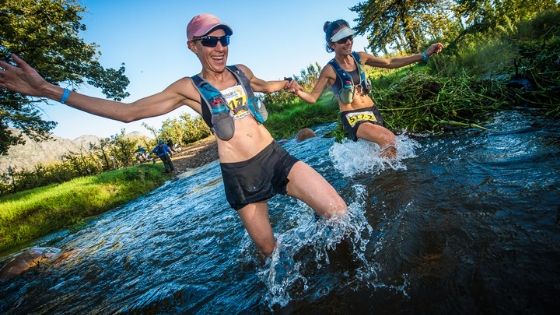
What Is The Difference between Waterproof and Non-Waterproof Trail Running Shoes?
When it comes to crossing rivers and running wet muddy trails, all trail running shoes get wet eventually, but here’s the difference between waterproof and no waterproof trail running shoes:
Waterproof:
- They are more expensive
- They are obviously waterproof, meaning no water can get in, or once wet, no water can get out either
- They are warmer
- They are windproof
- They don’t dry quickly once they’re wet, which makes them heavier. One downside of waterproof/GORE-TEX trail runners like that – if water does get inside them (which is likely it can take a long time for them to dry out. I’d recommend a back-up pair of shoes in your race drop bag in case this happens.
- They are mud and debris proof
- Once they are wet, they stay waterlogged and hence heavy for a long time.
Non-Waterproof:
- They are less expensive
- After submerged in a river crossing, they will dry out much quicker.
- Breathable, due to good ventilation
- Non-water-resistant means your feet will get wet more quickly
- the uppers are made from mesh or other lightweight materials
- These shoes have good drainage so after a river crossing, most of the water will get squeezed out within the first dozen or so paces.
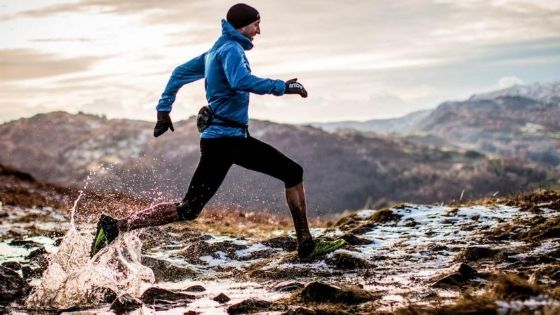
Is water-resistant and waterproof the same thing?
Waterproof is as the name implies impervious to water. Water-resistant trail running shoes are able to resist the penetration of water to some degree but not entirely. Water-repellent trail running shoes cause water droplets to bead and run-off, keeping the fabric dry. Let’s look at each in more detail.
WATERPROOF
The pinnacle of water protection. If you need reliable, guaranteed, best-in-class protection from mountain storms or downtown showers, or even on a sunny day when the weather takes a turn for the worst, “waterproof” is what you need.
WATER RESISTANT
Resistance is futile, as the famous historical saying goes. But we disagree. “Water resistance” may not offer 100%, cannot-ever-be-breached protection like “waterproof”. But it’s not every day, or during every activity, that you need that kind of protection.
When it comes to garments in the new GORE-TEX INFINIUM™ products range described as “water-resistant,” they offer you protection and comfort in a wide variety of conditions and situations. They’re perfect for a run in windy conditions, for that light rain that surprises you in the final mile, and at the champagne shower celebrations when you cross the finish line. Jackets made with GORE-TEX INFINIUM™ WINDSTOPPER® product technology, for example, are not only totally windproof, but they’re also water-resistant, making them ideal for a morning walk around the lake with friends, or cycling back home on your daily commute.
WATER REPELLENT
Think of this as the complement to the previous two. Water repellency can be found, for example, on the outer surface of all GORE-TEX jackets. In addition to the integrated membrane that guarantees waterproofness in these jackets, they also have a durable water repellency (DWR) treatment on their outer layer, which makes water bead up on the surface of the fabric, rather than penetrating the outer fabric.
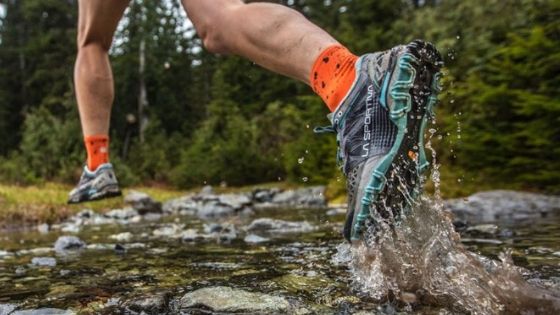
How To Taking Care of Water Proof/Resistant Trail Running Shoes?
When it comes to cleaning and taking care of waterproof and water-resistant trail running shoes your options are a little more limited than shoes that have not been specially treated.
Whatever coating is used to create that water-resistant or waterproof barrier, the coating will be vulnerable to abrasion. That is both physical abrasion and chemical abrasion.
Therefore any sand or grit that gets into your shoes will likely damage the protective coating on the fabric from within. Scuffing your shoes against rocks, tree roots and twigs will do the same on the outside.
As regards washing your trail running shoes, the manufacturers of the GORE-TEX membrane have some very specific instructions. Their website states that you should only use lukewarm water and a cloth or occasionally a very soft nylon brush. In other words no soaps or detergents at all. They also specifically state that you should never use bleach anywhere near any GORE-TEX product.
Before you start thinking about the possibility of soaking your trail running shoes in lukewarm water for any length of time, remember that the glues that are used to bond the outer sole, inner sole elements as well as the uppers to the sole are all water-based. Repeated soaking will compromise all of these bonds around the edges and reduce the life-span of your shoes.
The Waterproof Label Risk
There is a reluctance among shoe companies to use the label waterproof to describe their shoes.
A company may use a GORE-TEX waterproof membrane in the shoe and employ a water repellent coating to the outside of the shoe. In other words, do everything possible to create a genuine waterproof trail running shoe. In spite of all this that shoe will likely carry the label of being only water-resistant.
The reason for this is that the term “waterproof” is normally understood to be a permanent condition. What’s more, there is the belief that whatever has been ‘waterproofed’ will never fail due to contact with water – no matter the situation.
As we both know that trail running shoes that can never be 100% waterproof because of the big hole where your foot goes into the shoe. As a result, any claim of being waterproof simply exposes the company to the risk of lawsuits when inevitably water does get into the shoes.
Waterproofness at the expense of ventilation – What happens when your feet can’t breathe?
What many runners fail to realize is that the waterproof barrier is exactly that, a barrier. That means a barrier that is equally effective at keeping water inside the shoe as it is at keeping water out.
Once water spills in over the top of the cuff, you won’t get it out until you take your shoes off and allow them to slowly dry out in the shade.
Having water trapped inside your shoes will make them heavier and as such more tiring to run in. Your feet will also slide around inside the shoes potentially leading to blisters. Speaking from personal experience, wet feet also means the skin around your toenails getting soft. That makes losing a toenail a real possibility. I have been lucky never to lose a toenail, but I have felt a toenail trying to lift inside a wet shoe.
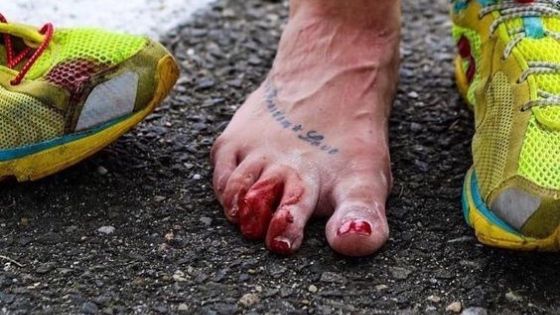
If like me, you live in a warmer climate, waterproof trail running shoes can cause your feet to overheat, thereby pushing up your core temperature. An increase in core temperature will elevate your heart rate. This could prove disastrous if you are overweight or have a heart condition.
There is another factor to think of should you wear waterproof trail running shoes in hot weather besides the irritation of rubbing and blisters.
All forms of foot fungi thrive in warm and wet conditions. At best this can lead to some bad odors. If you are less lucky, you can land up with a more serious fungal infection.
When Should You Wear Waterproof Trail-Running Shoes?
The one time that I have found waterproof trail running shoes outperforming other types of trail running shoes has been when running on snow. The waterproof uppers will keep snow from getting through. If you add gaiters to keep snow clear from the shoe cuff you will be just fine.
The waterproof lining will help keep your feet warm in the snowy conditions. I find that when I combine the use of Merino wool socks from Injinji (available on Amazon) my feet stay really cozy in the snow.
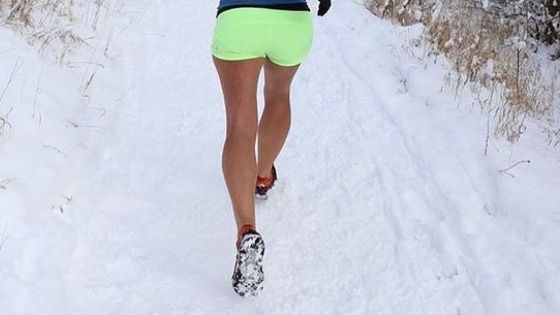
A second instance that I can think of where waterproof trail running shoes can prove to be useful is where conditions are damp rather than soaking wet while also cold. When I say cold I am referring to temperatures down in the region of freezing.
This would be those type of conditions where untreated trail running shoes can get wet and then potentially freeze onto your feet with the wind chill factor. In this case, the waterproof membrane will help block out the frigid air, protecting your feet.
When NOT to Wear Waterproof Trail-Running Shoes?
No matter whether it is somewhat damp or really wet, wearing your waterproof trail running shoes in warm weather is a bad idea. For me it makes my feet overheat and has lead to an elevated core temperature not to mention my fair share of blisters.
The other time to not wear your waterproof trail running shoes seems somewhat counter-intuitive. If conditions are really wet, waterproof trail running shoes will just trap more water inside your shoes. I have long ago come to terms with the fact that my feet will get wet in those circumstances.
It is way better for me to know that the water will drain out quickly and my feet will soon be dry again. That way I put wet feet into the same mental category as hitting any bad patch during a run. It feels uncomfortable but if I keep going it will start to feel better again.
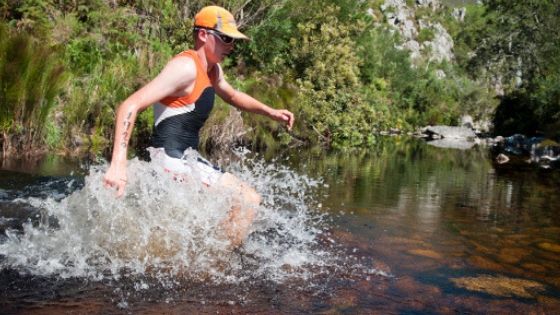
My Top Three Factors When Choosing Trail Running Shoes and Waterproof is NOT One of Them
My first consideration in a pair of new trail running shoes will be foot comfort. I am going to be spending many hours in my trail running shoes before they get to retirement. She life-span is measured in miles so the slower you run the more hours you will wear your shoes to cover the same number of miles.
The last thing that I want is for all of those potentially joyful running hours to be taken up by being miserable about foot discomfort.
My second consideration when I am choosing a pair of trail running shoes is whether the soles of the shoes will give me the traction that I need for the type of trail that I will be running on. Almost all of my trail running falls have been due to losing traction and slipping. I even tore a soleus muscle from a foot slipping. Though that was carrying groceries uphill on a wet road and not actually running.
My third consideration for choosing trail running shoes is durability. When I lace up my pair of trail running shoes I want to know that they will be able to at least carry me to the end of my run without incident.
When I do long, solo, unsupported mountain runs I can’t afford to have my trail running shoes come apart. Besides the mere inconvenience, broken shoes out in the backcountry miles from your next reliable water source could be catastrophic.
That is why I have a small roll of duct tape stored permanently in my running pack. Luckily so far I have not needed it. My selection of durable shoes that are fit for the conditions of that specific trail has meant that I have never yet had my trail running shoes break out on the trail.
Through a process of elimination after years of running and shoe testing, I have a narrowed down a very short list of the shoes I pick for different types of trail conditions. As I am not sponsored by any shoe company there is no brand loyalty in my list.
I have laid out my list in another post on this same site. You can see what I use for different types of trail and why I chose a specific shoe for a specific type of trail. Click on this link to see what different types of trail running shoes I have chosen over years of trial and error.
Different shoes for different conditions
Trail surfaces vary. Consequently, trail shoes will vary too. A shoe designed for soft muddy trails will have a different tread pattern from a pair made for sharp rocks or hard-pack earth.
A key part of Jim Walmsley’s record-breaking runs at both the 2018 and 2019 Western States 100 was changing shoes at aid stations so that he would have the best possible traction along the trail to the next aid station on a route that had everything from hard pack to soft snow.
Having the best possible traction certainly helped Walmsley run faster. However, it was the psychological aspect of heading out in the comfort of dry socks and shoes on freshly powdered feet that made him feel less fatigued.
Not all of us have the budget to be able to change shoes at each aid station on an ultra. However, making a single shoe change following a big river crossing can make the world of difference. Every ultra I have done I have always had a spare (usually older and more worn-in) pair of trail running shoes in my drop bag when drop bags have been permitted. Though I must admit never using them as yet though.
Next time I do a long unsupported mountain run I’ll be packing in two or three pairs of clean, dry socks and a small bottle of talc. I’m interested to test how stopping to powder my feet and change into dry socks will affect my overall performance.
